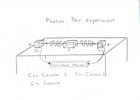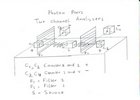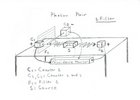The answer is a photon pair are two photons which are created by one event i.e. simultaneous
A much more important question is: How do you demonstrate that you are using a pair of photons.
The answer is by using a Coincidence Monitor or CM.
With a CM you can investigate the individual moments that the photons are counted and decide if they are simultaneous or not
The following experiment describes the most simple configuration of a Coincidence Monitor

|
The experiment takes place for a fixed duration of time t1.
- We have a source which tranmits photon pairs. One goes to the left one goes towards the right.
- Counter 1 is used to count the left photons. The total count is tn1.
- Counter 2 is used to count the left photons. The total count is tn2.
- A Coincidence Monitor to investigate the individual events. As such we get:
- n12: number of simultaneous events of counter 1 and 2
- n1: number of single events detected with counter 1
- n2: number of single events detected with counter 2

